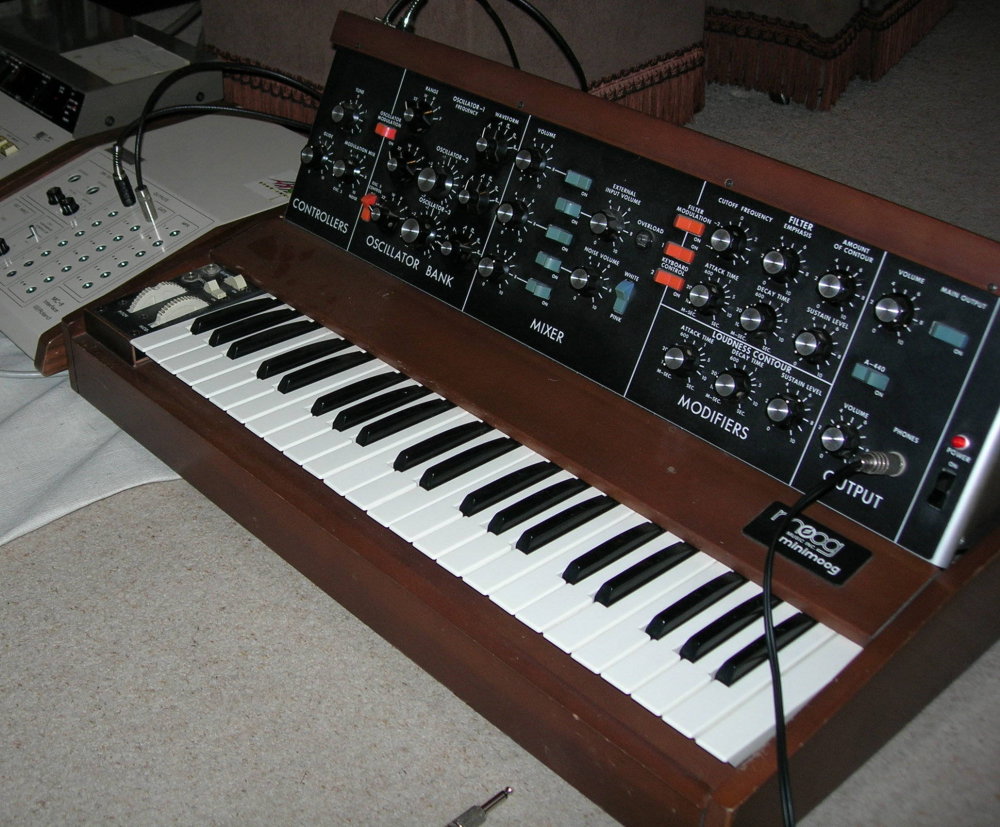Recently repaired one of the smallest analogue (in the main) synthesisers you will come across, the Yamaha CS01.

It can be the source of some very distinctive lead line sounds and is also great fun. This is synthesis at its most basic with only twenty controls (including the Mod and Pitch wheels) and 32 mini keys. There were two versions, the original CS01, released in 1982, which was metalic grey with a light blue labeling and the later CS01-II, released in 1984, that was mainly black with flourescent green lines and an upside down ‘YAMAHA’. I have seen a black version of the Mk1 and rumour has it that there was also an even less common version of the original version in red.
The voice architecture is a single ‘Voltage Controlled Oscillator’, Voltage Controlled Filter and a Voltage Controlled Amplifier with a single Envelope Generator and Low Frequency Oscillator as modulation sources. Having whipped the back off one I have my doubts that the VCO is analogue although the rest of the circuitry looks pretty conventional.
The layout of the front panel from left to right is as follows:-
Controllers: Directly to the left of the keyboard, where you would expect the performance controls, is the Power/Volume control plus the Breath Controller sensitivity controls for VCA and VCF. The Pitch Bend and Modulation wheels are at the back of the panel to the left of the keyboard with a modulation destination switch below them. This switch selects where the LFO output goes, to VCO or the VCF. Sadly the Pitch Bend is only up (sharp).
Behind the 32 note mini key (F-C) top note priority keyboard are the rest of the controls laid out in seperate sections, they are all sliders or switches that look like sliders.
LFO: First up is the ‘LFO Speed’ control. The LFO wave shape is a triangle shape only with a range of 0.5Hz – 10Hz.
VCO: The VCO section has five controls, Glissando, Pitch, Feet, Wave and PWM Speed. Glissando, instead of portamento is another giveaway that the VCO is digital although at the faster speeds the effect is virtually identical to portamento (thankfully). Pitch is a fine tune control with a range of plus or minus a semitone. Feet is a slider control with five stops, 4′, 8′, 16′, 32′ and WN which replaces the current VCO waveshape with white noise (that has no pitch). Wave is also a five way switch that selects Triangle, Sawtooth, Square, Fixed Pulse and Pulse Width Modulated waveshapes. The PWM Speed slider controls the speed of the dedicated PWM LFO (nice idea…).
VCF: Next is the VCF Cutoff Frequency slider that controls the cutoff of the fairly weak, 12dB / octave, VCF. Worse still the Resonance control is a two position switch (on the original) that selects resonance low or high. Thankfully this was replaced on the CS01-II with a proper slider and the VCF was also beefed up. Finally there is an EG Depth slider that behaves as expected.
VCA: has an EG Depth control that is a single slider that controls the effect that the EG has on the VCA .
EG: Finally there is a conventional ADSR envelope with a slider for each segment of the envelope.
On the left hand end is a socket for a Yamaha BC1 breath controller and on the right hand end are sockets for Line Out, Phones and a nine volt half-brick (power supply).
The last two inches of the front panel are taken up by a small speaker that can be used for monitoring the sound. As the CS01 can be powered by six ‘AA’ batteries this makes it completely portable and it can be used anywhere. This portability is one of the keys to the success of the instrument. If you use the line out socket (thus muting the internal speaker) and attach a guitar strap to the thoughtfully positioned strap buttons we are now into the ‘stroll around, pose like crazy, Jan Hammer school of playing and great fun it is too! The weird positioning of the perfomance controls now make sense as you just curl your fingers round the rear of the case to reach them and even the upside down ‘Yamaha’ on the CS01-II now looks right.
So whats all the fuss about? Well once freed from the constraints of the tiny internal speaker the instrument sounds quite powerful through a decent set of speakers. Coupled with the BC1 breath contoller the expression that can be added to lead lines is quite amazing considering the simplicity of the voice architecture. However the down side is that you look a complete (dribbling) prat while using it which is perhaps that is why the breath controller never caught on.
Because some people think these are toys (and not a true synthesiser) means there are bargains to be had. Sometimes found in car boot sales amongst other mini-keyed home keyboards you may pick one up for virtually nothing (I only paid twenty five quid for mine) and for my money that was an absolute steal.
If you see one cheap – buy it…


